List of Indian spices
Indian spices include a variety of spices grown across the Indian subcontinent (a sub-region of South Asia). With different climates in different parts of the country, India produces a variety of spices, many of which are native to the subcontinent. Others were imported from similar climates and have since been cultivated locally for centuries. Pepper, turmeric, cardamom, and cumin are some example of Indian spices.
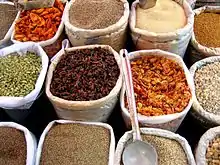
Spices are used in different forms: whole, chopped, ground, roasted, sautéed, fried, and as a topping. They blend food to extract the nutrients and bind them in a palatable form. Some spices are added at the end as a flavouring — those are typically heated in a pan with ghee or cooking oil before being added to a dish. Lighter spices are added last, and spices with strong flavour should be added first. "Curry" refers to any dish in Indian cuisine that contains several spices blended together, whether dry or with a gravy base. However, it also refers to Curry leaves, commonly used in South India.
Below is a list of spices and other flavouring substances commonly used in India.[1]
| Image | Standard English | Notes | |
|---|---|---|---|
| Alkanet Root | |||
| Amchoor | Dried green and unripe mango powder | ||
 |
Asafoetida | Intensely aromatic - flavor profile sometimes compared to that of truffles and garlic | |
 |
Black cardamom | Very earthy and darkly aromatic. Often used in North Indian curries. | |
 |
Black pepper | Pepper may be used whole or ground in Indian cuisines. The largest producer is the southern Indian state of Kerala. | |
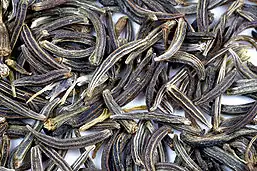 |
Black cumin | Sweet, floral and smokey cumin and anise-like flavour. Smaller in size than regular cumin. Often mistaken as Caraway seed. Though English translation is black cumin, the term black cumin is also used as English translation of Nigella sativa, kalonji | |
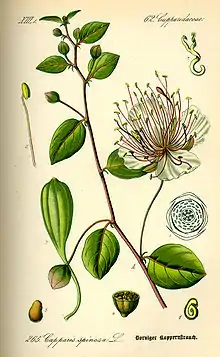 |
Capers | ||
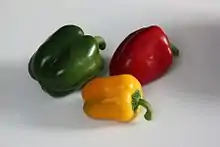 |
Capsicum | ||
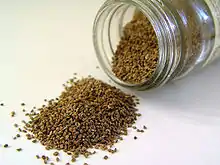 |
Celery / Radhuni seed | ||
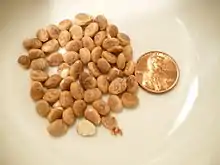 |
Charoli | a type of nut particularly used in making desserts | |
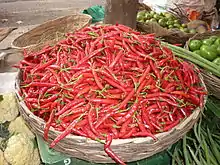 |
Chili pepper powder | ||
 |
Bay leaf, Indian bay leaf | Both Indian bay leaf and bay leaf are similar and called as Tej Patta in Hindi. However, they are from two different species and have differences in taste | |
| Cinnamon buds | |||
 |
Cinnamon | Grown commercially in Kerala in southern India. Two types, cassia (common) and royal. | |
 |
Citric acid | ||
 |
Cloves | Kerala, Tamil Nadu, and Karnataka are largest producers in India. | |
| Coriander Powder | |||
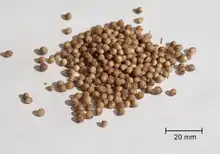 |
Coriander Seed | ||
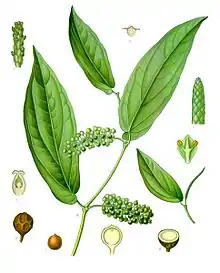 |
Cubeb | Tastes of clove with added bitterness with a persistent mild numbing sensation | |
 |
Cumin seed | See Kali Jeera. | |
| Cumin seed ground into balls | |||
 |
Curry tree or sweet neem leaf | Cannot retain flavour when dried. Only used fresh. | |
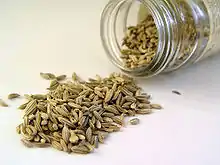 |
Fennel seed | ||
 |
Fenugreek leaf | ||
 |
Fenugreek seed | ||
| Four seeds | Seeds of watermelon, musk melon, cucumber and pumpkin | ||
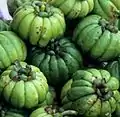 |
Garcinia gummi-gutta | Used in fish preparations of Kerala | |
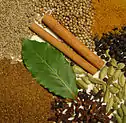 |
Garam masala | Blend of 8+ spices. Each family has their own secret recipe. | |
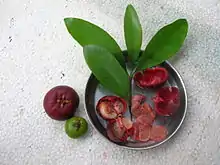 |
Garcinia indica | ||
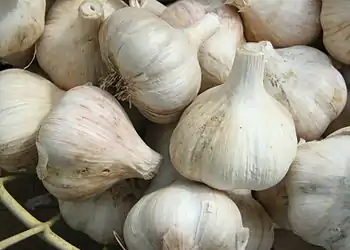 |
Garlic | ||
 |
Ginger | ||
 |
Dried ginger | mostly powdered | |
 |
Green cardamom | Malabar variety is native to Kerala. | |
 |
Green chili pepper | ||
| Indian bedellium tree | Very earthy aromatic mostly used in religious | ||
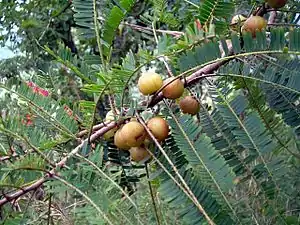 |
Indian gooseberry | ||
_hanging_fruit_at_23_Mile%252C_Duars%252C_WB_W_IMG_5902.jpg.webp) |
Inknut | ||
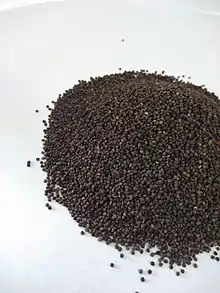 |
Jakhya | Tasteless and odorless when uncooked; Earthly and crunchy when crackled in oil. | |
| Kalpasi | Also known as black stone flower | ||
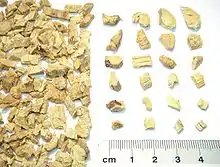 |
Licorice powder | ||
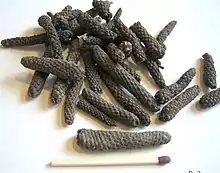 |
Long pepper | ||
| Mango Extract | |||
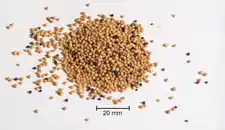 |
Mustard seed | ||
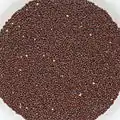 |
Brown mustard Seed | ||
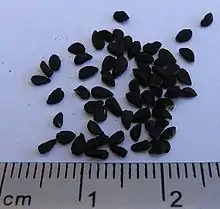 |
Nigella seed | ||
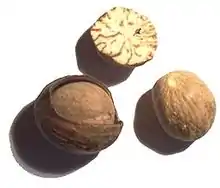 |
Nutmeg | Whole nuts last forever. Powder, only a month. | |
 |
Mace | Mace is outer covering to nutmeg nut. Similar aroma. | |
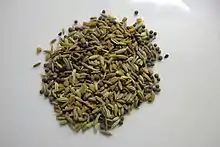 |
Panch phoron | This is a Bengali spice mix that combines fennel seeds, cumin seeds, fenugreek seeds, mustard seeds and nigella seeds. | |
 |
Pomegranate seed | Dried and ground in the Middle East. | |
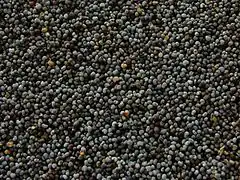 |
Poppy seed | Very popular in West Bengal known posto, with no of Bengali cuisine, most popular Allu Posto | |
| Saffron pulp | Actually, safflower concentrate | ||
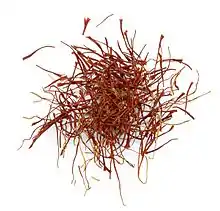 |
Saffron | World's most expensive spice. Used for rice flavouring. | |
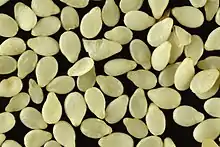 |
Sesame seed | ||
 |
Star aniseh | Exotic, Chinese-influenced flavours | |
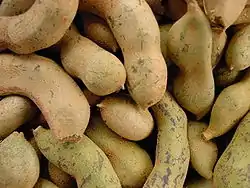 |
Tamarind | Provides tartness in South Indian curries | |
 |
Thymol/carom seed | ||
 |
Turmeric | Source of yellow color in many curries. | |
| Gum Tragacanth | A thickener and coating for desserts | ||
 |
White pepper |
See also
- Spice trade
- Masala dabba, traditional spice box
- Spice Mixes
External links
- "Spices List - Indian Names". TheSpiceMarket. Retrieved 2 October 2013.
- "Glossary Pakistani & Indian Spices (Masala)". Direct Advert Media LLC. Retrieved 2 October 2013.
- Waves Of Love Spice Mixes
- "Glossary of Food Ingredients". Cymran LLC. Retrieved 2 October 2013.
- "Glossary of Spices & Condiments - Indian Names". Syvum Technologies Inc. Retrieved 2 October 2013.
- Gantzer, Hugh; Gantzer, Colleen (2014). SpiceStory. Spices Board of India. ISBN 9789383098385.CS1 maint: ref=harv (link)
- Raghavan, Susheela (2006). Handbook of Spices, Seasonings, and Flavorings (2nd ed.). Hoboken: CRC Press. ISBN 9781420004366.